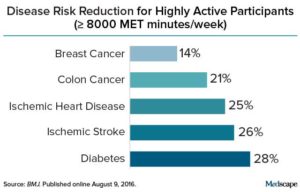 Looks like exercise, even 20 minutes of moderate activity such as brisk walking, has beneficial anti-inflammatory health effects. Inflammation is part of the body's normal immune response - it is the body's attempt to heal itself after an injury and tissue damage, and to defend itself against infection from foreign invaders, such as viruses and bacteria.
Looks like exercise, even 20 minutes of moderate activity such as brisk walking, has beneficial anti-inflammatory health effects. Inflammation is part of the body's normal immune response - it is the body's attempt to heal itself after an injury and tissue damage, and to defend itself against infection from foreign invaders, such as viruses and bacteria.
However, chronic inflammation (e.g., what can occur in obesity, diabetes, and poor lifestyle) can lead to serious health issues and is linked to cancer, heart disease, etc. So lowering chronic (systemic) inflammation is good. From Science Daily:
Exercise ... It does a body good: 20 minutes can act as anti-inflammatory
It's well known that regular physical activity has health benefits, including weight control, strengthening the heart, bones and muscles and reducing the risk of certain diseases. Recently, researchers at University of California San Diego School of Medicine found how just one session of moderate exercise can also act as an anti-inflammatory. The findings have encouraging implications for chronic diseases like arthritis, fibromyalgia and for more pervasive conditions, such as obesity.
The study, recently published online in Brain, Behavior and Immunity, found one 20-minute session of moderate exercise can stimulate the immune system, producing an anti-inflammatory cellular response. The brain and sympathetic nervous system -- a pathway that serves to accelerate heart rate and raise blood pressure, among other things -- are activated during exercise to enable the body to carry out work. Hormones, such as epinephrine and norepinephrine, are released into the blood stream and trigger adrenergic receptors, which immune cells possess. This activation process during exercise produces immunological responses, which include the production of many cytokines, or proteins, one of which is TNF -- a key regulator of local and systemic inflammation that also helps boost immune responses.
The 47 study participants walked on a treadmill at an intensity level that was adjusted based on their fitness level. Blood was collected before and immediately after the 20 minute exercise challenge."Our study shows a workout session doesn't actually have to be intense to have anti-inflammatory effects. Twenty minutes to half-an-hour of moderate exercise, including fast walking, appears to be sufficient," said Hong.
Inflammation is a vital part of the body's immune response. It is the body's attempt to heal itself after an injury; defend itself against foreign invaders, such as viruses and bacteria; and repair damaged tissue. However, chronic inflammation can lead to serious health issues associated with diabetes, celiac disease, obesity and other conditions.

 Again, another study showing the importance of lifestyle factors in the development of protein buildups in the brain that are associated with the onset of Alzheimer's disease. Specifically, the study found that each one of several lifestyle factors—a healthy body mass index, physical activity and a Mediterranean diet, were linked to lower levels of plaques and tangles on brain scans in people who already had mild memory changes, (but not dementia). Other posts discussing Mediterranean diet and brain health (brain volume, etc.) are
Again, another study showing the importance of lifestyle factors in the development of protein buildups in the brain that are associated with the onset of Alzheimer's disease. Specifically, the study found that each one of several lifestyle factors—a healthy body mass index, physical activity and a Mediterranean diet, were linked to lower levels of plaques and tangles on brain scans in people who already had mild memory changes, (but not dementia). Other posts discussing Mediterranean diet and brain health (brain volume, etc.) are  Credit: Medscape
Credit: Medscape Another study showing that higher physical activity (from a variety of activities) is "related to larger gray matter volume in the elderly, regardless of cognitive status", specifically in gray matter areas of the brain responsible for memory, learning, and cognition. In other words, higher levels of physical activity reduce brain atrophy that occurs with aging and improves cognitive function in elderly individuals. There is also discussion of higher activity levels improving cerebral (brain) blood flow. Bottom line: get off your butt and move more for better brain health. From Medical Xpress:
Another study showing that higher physical activity (from a variety of activities) is "related to larger gray matter volume in the elderly, regardless of cognitive status", specifically in gray matter areas of the brain responsible for memory, learning, and cognition. In other words, higher levels of physical activity reduce brain atrophy that occurs with aging and improves cognitive function in elderly individuals. There is also discussion of higher activity levels improving cerebral (brain) blood flow. Bottom line: get off your butt and move more for better brain health. From Medical Xpress: